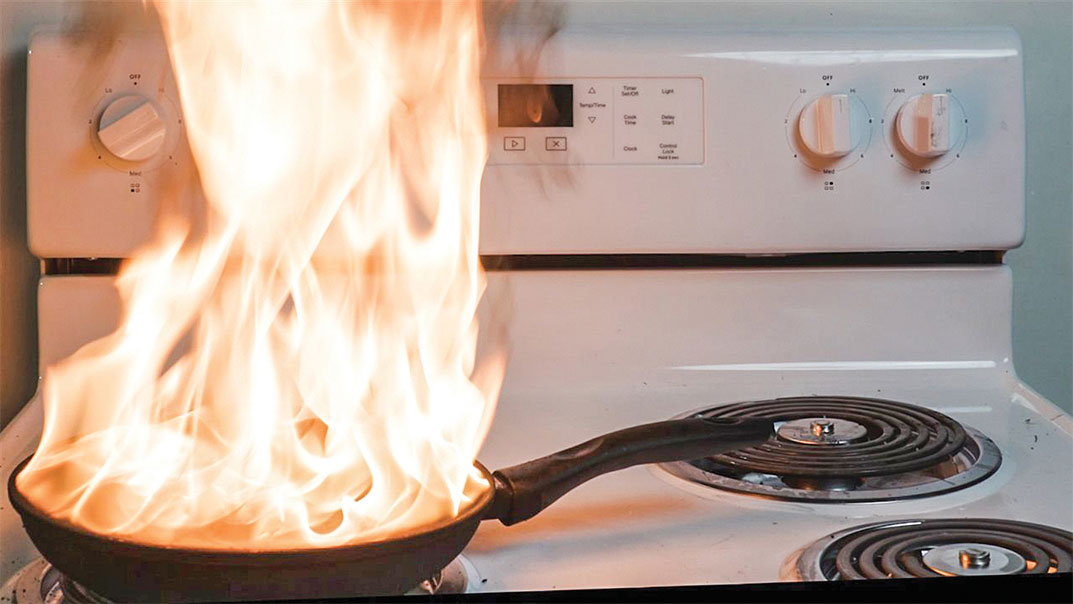Safety tips to prevent fires in the kitchen
The kitchen is the heart of the home, where you cook meals, bake treats and prep lunches for the next day. It is an essential space but can also be a dangerous one due to the risk of kitchen fires.
According to the National Fire Protection Association, cooking is the leading cause of both home fires and home fire injuries in the United States. Between 2017 and 2021, fire departments responded on average to 158,400 kitchen fires each year, causing an average of 470 deaths, 4,150 injuries and more than $1.15 billion in direct property damage.
UL’s Fire Safety Research Institute is bringing attention to how fast a cooking fire can spread through the kitchen and to the rest of the home and ways that homeowners and renters can keep themselves and their loved ones safe. Their fire safety experts share simple ways to significantly lower the chance of experiencing a fire in the kitchen and how to plan ahead in case it does happen.
HAVE SMOKE ALARMS
If a kitchen fire does start, smoke alarms will provide the earliest alert that there is an incident. You should have a smoke alarm inside and outside every sleeping area, on every level of the home. Any smoke alarms in the kitchen should be installed at least 10 feet away from any cooking source. This distance will allow the smoke alarms to quickly detect a fire but will be far enough away to lower the occurrence of false or nuisance alarms.
KEEP A CLEAN AREA
While cooking, turn pot handles inward toward the back of the stove so that they don’t accidentally get bumped and knocked over. Additionally, make sure to keep oven mitts, plastic utensils, packages and other flammable materials away from the stovetop. If these items are stored too close to an open flame or heat source, they can ignite.
STAY AWARE
Stay by your stove while cooking and, if you must leave, turn the burners off. Unattended cooking equipment contributed to 49% of residential kitchen fires, according to the National Fire Protection Association. Momentary lapses in attention can have serious consequences.
COOK WITH CARE
In addition to staying near the stove, you should pay attention to what you’re cooking so you can watch for smoke, boiling grease or other signs that the heat is too high. If a fire does ignite, use a pan lid or baking sheet to cover the pan — this will remove oxygen from the fire and put it out.
PRACTICE YOUR PLAN
While the kitchen is frequently where home fires start, the reality is they can occur anywhere in the home and at any time. To be better prepared, consider these steps for establishing a family fire safety plan.
STEP 1: CHECK SMOKE ALARMS
In the event of a home fire, you may have as little as three minutes to safely escape from the time the fire starts. Smoke alarms can give you and your family the earliest possible warning of a house fire — allowing you to escape quickly. Check your smoke alarms twice a year and replace them once they stop working according to the manufacturer’s recommendations. When replacing or buying new smoke alarms, look for products that are third-party listed or certified.
Do not disable your smoke alarms. People may disable their smoke alarms due to annoying false alarms set off by steam from cooking. However, new technology helps alarms distinguish between smoke from a real fire and non-threatening smoke/ steam from cooking and are a good option if false alarms from cooking are a common problem. Consider upgrading to modern smoke alarm options to protect your home and your family.
No matter what type of smoke alarm you have, the best smoke alarm is a working one.
STEP 2: CLOSE DOORS
A closed door can effectively protect you from carbon monoxide, smoke and flames in the event of a house fire, providing valuable time to respond to smoke alarms, escape quickly or to get behind a closed door as far away from the fire as possible if you cannot escape.
According to the UL’s Fire Safety Research Institute, in the event of a fire, a room with a closed door can be 900 degrees Fahrenheit cooler than a room with an open door.
Close the doors in your house as part of your nighttime routine — it could save your life.
STEP 3: AN ESCAPE PLAN
If there is a fire, there won’t be time to plan a way out in the moment. Make sure you and your family are prepared by determining a fire escape plan and practicing it in advance.
Every escape plan should include Plan A, B and C.
Plan A – Exit your home through the closest door (close it behind you) and go to your meeting place to call 911.
Plan B – If you can’t safely exit through the closest door, you may need to use another exit or window. Close the door and/or window behind you, if you can, and go to your meeting place to call 911.
Plan C – If you can’t get out, get behind a closed door and call 911, and tell the dispatcher where you are inside the home.
To learn more about how to help your family plan ahead before a fire starts, visit closeyourdoor.org.
This article is courtesy of Brandpoint.
